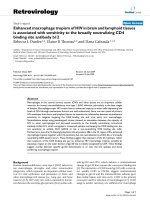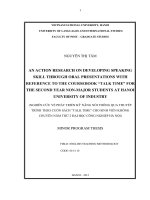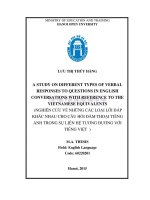- Trang chủ >>
- Cao đẳng - Đại học >>
- Luật
Modernising and Harmonising Consumer Contract Law With Reference to the Planned Horizontal Consumer Contract Directive 2
Bạn đang xem bản rút gọn của tài liệu. Xem và tải ngay bản đầy đủ của tài liệu tại đây (1004.27 KB, 333 trang )
Modernising and Harmonising
Consumer Contract Law
Modernising and Harmonising
Consumer Contract Law
edited by
Geraint Howells
Reiner Schulze
ISBN 978-3-86653-082-9
The Deutsche Nationalbibliothek lists this publication in the Deutsche
Nationalbibliografie; detailed bibliographic data are available on the Internet at
© 2009 by sellier. european law publishers GmbH, Munich.
All rights reserved. No part of this publication may be reproduced, translated,
stored in a retrieval system or transmitted, in any form or by any means, electronic,
mechanical, photocopying, recording or otherwise, without prior permission of
the publisher.
Design: Sandra Sellier, Munich. Production: Karina Hack, Munich.
Typeface: Goudy Old Style and Goudy Sans from Linotype. Printing and binding:
Friedrich Pustet KG, Regensburg. Printed on acid-free, non-ageing paper.
Printed in Germany.
8Foreword
In October 2008 the European Commission published the Proposal for a Consumer Rights Directive; a Proposal that suggests far-reaching changes to the
core of consumer contract law. Four current directives shall be replaced by a
new, overarching piece of legislation and in doing so full harmonisation should
for the most part take the place of the minimum standard presently in force in
the European Union. In January 2009, legal experts from universities, practice
and the civil service met in Manchester to address the question of the extent to
which this Proposal can contribute to the modernisation and harmonisation of
European consumer contract law. This event was organised under the auspices
of the Consumer Law Academic Network (CLAN) jointly by the Manchester
University Law School and Münster’s Centre for European Private Law and
benefited from support from the UK Department for Business, Enterprise and
Regulatory Reform (BERR), Domestic and General and the Acquis Group.
The papers presented at this conference analysed, criticised and suggested
improvements for the Proposal and are published in this volume.
The editors would like to thank the contributors and the publisher for
their efforts in making the publication possible in such an exceptionally short
period. The results from this conference are thereby timely for the further
discussions on a Consumer Rights Directive.
Further thanks are due to Eric Sitbon, legislative officer at DG SANCO,
and Graham Branton of BERR for their important contributions and valued
participation at the conference.
The editors would like to particularly thank David Kraft and Jonathon
Watson for their conscientiousness and commendable dedication to the organisation of the conference and co-ordination of this publication, as well as
Joana Tolle for her assistance.
Manchester/Münster, January 2009
Geraint Howells and
Reiner Schulze
9Contributors
Hugh Beale
Professor of Law, University of Warwick, United Kingdom.
Visiting Professor at the University of Oxford, United Kingdom, and
Honorary Professor at the University of Amsterdam, The Netherlands
Roger Brownsword
Professor of Law and Director of TELOS at the School of Law,
King’s College London and Honorary Professor in Law at the
University of Sheffield, United Kingdom
Geraint Howells
Professor of Commercial Law, University of Manchester, United Kingdom.
Barrister, Gough Square Chambers, United Kingdom
Marco Loos
Professor of Private Law, in particular of European Consumer Law,
University of Amsterdam, The Netherlands; associated with the
Centre for the Study of European Contract Law of that university
Vanessa Mak
Post-doctoral fellow, Tilburg Institute of Comparative and
Transnational Law (TICOM), Tilburg University, The Netherlands
Hans-W. Micklitz
Professor of Economic Law, European University Institute, Florence, Italy
Annette Nordhausen Scholes
Lecturer in law, University of Manchester, United Kingdom
Christine Riefa
Brunel University, United Kingdom. Convenor of the European Masters
in Consumer Affairs (EU funded) and Board Member of the
International Association of Consumer Law
Hans Schulte-Nölke
Professor of Civil Law, European Private and Business Law,
Comparative Law, and European Legal History.
Director of the European Legal Studies Institute, Osnabrück, Germany
VIII
Contributors
Reiner Schulze
Professor of German and European Civil Law at the University of
Münster, Germany.
Director of the Centre for European Private Law (CEP), Münster, Germany
Jules Stuyck
Professor of European Law and Consumer Law at the K.U. Leuven
and director of the Study Centre for Consumer Law.
Partner Liedekerke, Brussels, Belgium
Christian Twigg-Flesner
Reader in Law and Convenor of the Trade and Commercial Law Centre,
University of Hull, United Kingdom
Chris Willett
Professor of Consumer Law, De Montfort University, Leicester,
United Kingdom
Fryderyk Zoll
Professor of Law, Jagiellonian University, Cracow, Poland
10Contents
Foreword
Contributors
V
VII
Part I
Introduction
Overview of the Proposed Consumer Rights Directive
Geraint Howells & Reiner Schulze
3
Part II
Scope and Values of the Proposal
Scope and Role of the Horizontal Directive and
its Relationship to the CFR
Hans Schulte-Nölke
29
The Targeted Full Harmonisation Approach:
Looking Behind the Curtain
Hans-W. Micklitz
47
Part III
Good Faith and Unfair Terms
Regulating Transactions:
Good Faith and Fair Dealing
Roger Brownsword
Unfair Terms
Jules Stuyck
87
115
X
Contents
Part IV
Sales and Direct Producer Liability
Fit for Purpose? The Proposals on Sales
Christian Twigg-Flesner
147
A Dangerous Erosion of Consumer Rights:
The Absence of a Right to Withdraw from Online Auctions
Christine Riefa
177
Direct Producer Liability
Chris Willett
189
Part V
Information Requirements, Withdrawal and Remedies
Information Requirements
Annette Nordhausen Scholes
213
Rights of Withdrawal
Marco Loos
237
The Remedies for Non-Performance in the Proposed
Consumer Rights Directive and the Europeanisation of Private Law
Fryderyk Zoll
279
Part VI
The UK Context
The Draft Directive on Consumer Rights and UK Consumer Law –
Where now?
Hugh Beale
289
Part VII
Discussion Paper
The Degree of Harmonisation in the Proposed Consumer Rights Directive:
A Review in Light of Liability for Products
Vanessa Mak
305
Part I
Introduction
11Overview of the
Proposed Consumer Rights Directive
Geraint Howells & Reiner Schulze
I.
Introduction
On the 8 October 2008 the Commission published a Proposal for a Directive on Consumer Rights (hereafter referred to as Proposal or pCRD).1 First
mooted back in 2004,2 when the project was firmly integrated into the general
programme for reforming European contract law, the project began to take
shape in 2007 with the Green Paper on the Review of the Consumer Acquis.3
Originally covering eight consumer directives4 the final Proposal focuses in
on just four that lie at the heart of consumer contract law: Council Directive 85 / 577 / EEC of 20 December 1985 to protect the consumer in respect of
contracts negotiated away from business premises;5 Directive 97 / 7 / EC of the
European Parliament and of the Council of 20 May 1997 on the protection of
consumers in respect of distance contracts;6 Council Directive 93 / 13 / EEC of
5 April 1993 on unfair terms in consumer contracts;7 Directive 1999 / 44 / EC of
the European Parliament and of the Council of 25 May 1999 on certain aspects
of the sale of consumer goods and associated guarantees.8
1
2
3
4
5
6
7
8
COM(2008) 614 final.
See COM(2004) 651 final, OJ 2005 C 14 / 6.
COM(2006) 744 final.
The other four were Council Directive 90 / 314 / EEC of 13 June 1990 on package
travel, package holidays and package tours, OJ 1990 L 158 / 59; Directive 94 / 47 / EC
of the European Parliament and the Council of 26 October 1994 on the protection
of purchasers in respect of certain aspects of contracts relating to the purchase of the
right to use immovable properties on a timeshare basis, OJ 1994 L280 / 83; Directive
98 / 6 / EC of the European Parliament and of the Council of 16 February 1998 on
consumer protection in the indication of the prices of products offered to consumers,
OJ 1998 L 80 / 27 and Directive 98 / 27 / EC of the European Parliament and of the
Council of 19 May 1998 on injunctions for the protection of consumers’ interests,
OJ 1998 L 166 / 51.
OJ 1985 L 372 / 31.
OJ 1997 L 144 / 19.
OJ 1993 L 95 / 29.
OJ 1999 L171 / 12.
Geraint Howells & Reiner Schulze
4
The project is now well focused on key areas of consumer contract law
and although seeking to be informed by the Common Frame of Reference
(hereafter: CFR) the project has been produced in advance of the CFR being
available.9 Indeed one of our broad general observations about the Proposal
in the next section concerns the way in which it uses and relates to the CFR.
Another central theme addressed in this overview section is full harmonisation. The goal of full harmonisation has been modified in rhetoric to targeted
full harmonisation. However, in practice full harmonisation remains at the
core of the Directive. Linked to this is the question of whether the Proposal
addresses the concerns of the internal market consumer. Building confident
internal market consumers is the worthy objective underpinning this Proposal,
but the unerring belief in full harmonisation combined with some of the policy
choices risks reducing consumer protection in some Member States. Finally
the attempts to modernise consumer contract law to take account of changes
in technology and market practices will be discussed. After this overview key
provisions will be briefly analysed.
II.
General policy observations
1.
The Consumer Rights Directive and general contract law –
the influence of the CFR
The purpose of the CFR is a much debated topic.10 Indeed within the Commission there have been notable ebbs and flows in emphasis with at times the
notion of an optional instrument being more prominent than at others. The
notion of the CFR as a toolbox has, however, been a constant (even if recently
the term “handbook” is becoming more popular11); by which seems to be understood an aid to, amongst others, the European legislator when drafting laws.
Under Commissioner Kyprianou there was a discernable drawing back of the
engagement of DG SANCO so that its interest in the CFR was increasingly focused on its utility for the reform of consumer law – connected with the review
9
10
11
The basis of this project is the Action Plan for a more coherent contract law,
COM(2003) 68 final, OJ 2003 C 63 / 1. For more details see D. Staudenmayer,
Weitere Schritte im Europäischen Vertragsrecht, (2005) Europäische Zeitschrift für
Wirtschaftsrecht 103. For recent developments of the CFR see Council documents
8286 / 08, (11.4.08) and 15306 / 08 (07.11.08) and the resolution from the European
Parliament B6-0374 / 2008 (17.07.08).
Cf. H. Eidenmüller, F. Faust, H. Grigoleit, N. Jansen, G. Wagner, R. Zimmermann,
Der gemeinsame Referenzrahmen für das Europäische Privatrecht – Wertungsfragen
und Kodifikationsprobleme, (2008) 11 Juristen Zeitung 529-550.
See, for example, COM(2007) 447 final, at p. 10.
Overview of the Proposed Consumer Rights Directive
5
of the Acquis.12 However, the role of the CFR in simplifying, modernising and
improving the Consumer Acquis, nevertheless could be a very tangible beneficial output. The timing of the Proposed Consumer Rights Directive is in that
respect unfortunate as this fundamental building block of the future European
consumer contract law has been proposed at a time when the CFR is still in
preparation. The draft CFR (hereafter: DCFR)13 does exist and yet we shall see
that – in crucial areas where it has sought to address the consumer contract acquis such as information duties and rights of withdrawal – the DCFR does not
seem to have left a strong impression on the text. Indeed the Proposal makes
no mention of the DCFR; the aforementioned Green Paper only mentioned it
in the context of a number of stakeholder meetings that had been arranged.14
Given the large investment in the CFR one might have expected the draft to
have been, if not centre stage in the reform process, at least one of the main
players. Of course the DCFR is still only an academic text and it has no political clout or binding authority, but one would have expected at the very least
its solutions to have been mentioned and deviations explained.
The Proposal draws back from some of the more ambitious issues floated
in the Green Paper. The outcome of the consultation process seems to have
been that the Commission was cautioned against including reforms like a
general clause of good faith and fair dealing, the extension of the scope of the
unfairness test to all contract terms and a general right to damages.15 This may
indeed be sensible if such broader topics are to be incorporated into a coherent
CFR. The Proposal could then be seen as a two stage process – dealing with
12
13
14
15
Cf. H. Schulte-Nölke, Scope and Role of the Horizontal Directive and its Relationship to the CFR, in this volume.
Principles, Definitions and Model Rules of European Private Law, Draft Common Frame
of Reference (DCFR) Interim Outline Edition, edited by C. von Bar et al., (Munich:
Sellier, 2008); also available online at www.law-net.eu. A revised edition is due
to be published by Sellier in February 2009. For literature on this subject see e.g.
C. von Bar, European Coverage and Structure of the Academic Common Frame
of Reference, (2007) 3 European Review of Contract Law 350-361; O. Lando, The
Structure and the Legal Values of the Common Frame of Reference (CFR) (2007)
3 European Review of Contract Law 245-256; R. Schulze / T. Wilhelmsson, From the
Draft Common Frame of Reference towards European Contract Law Rules, (2008)
4 European Review of Contract Law 154-168; Common Frame of Reference and Existing
EC Contract Law, edited by R. Schulze, (Munich: Sellier, 2008); H. Beale, The Future of the Common Frame of Reference, (2007) 3 European Review of Contract Law.
257-276; T. Pfeiffer, Von den Principles of European Civil Law zum Draft Common
Frame of Reference, (2008) 4 Zeitschrift für Europäisches Privatrecht 679-707.
The documents from the consultation proceedings are available under: http: // ec.
europa.eu / consumers / rights / cons_acquis_en.htm.
Commission Staff Working Document accompanying the proposal for a directive on consumer rights Impact Assessment Report at p. 20: available at http: // ec.
europa.eu / consumers / rights / docs / impact_assessment_report_en.pdf.
Geraint Howells & Reiner Schulze
6
some specific matters in this Proposal and more broad ranging matters once
the CFR was in place. However, even this first stage needs to be more clearly
linked to the general CFR framework, unless the need for early revision is to
be avoided.
2.
Targeted full harmonisation
The Proposal clearly sees itself as the successor of the Unfair Commercial
Practices Directive16, which is lauded for its successful adoption of maximal
harmonisation.17 Maximal harmonisation certainly has a role to play in European consumer law.18 The Commission is clearly motivated by the fact that
cross-border sales are not taking off either in distant selling (especially via the
Internet) or direct selling (it cites the example of utilities in border areas) and
consumers are not therefore feeling the full benefits of the internal market.19 In
which sectors and to what extent the lack of harmonisation of the rules really
is a significant inhibitor of cross-border trade needs to be further evaluated.20
Nevertheless, where consumer law can be harmonised at a maximum level
without affecting consumer protection this is surely a worthwhile goal. It may
be expected, in particular, to be appreciated by small and medium sized enterprises (SMEs) that lack large in-house legal teams to advise on the differences
between laws in Member States and whose cross-border sales may be in small
quantities that do not justify modifying products, packaging or contracts for
new markets.
However, contract is different from unfair commercial practices. Whereas
commercial practice law may constrain what is allowed to be done or require
certain things to be done so that, in principle, a full harmonisation may be
justified,21 not all contract rules impose such direct obligations. Some information duties and different rules on withdrawal may produce such barriers
to trade and might justify full harmonisation. The same might apply to some
aspects of unfair terms if the use of common contract documents across Europe
16
17
18
19
20
21
Directive 2005 / 29 / EC of the European Parliament and of the Council of 11 May
2005 concerning unfair business-to-consumer commercial practices in the internal market and amending Council Directive 84 / 450 / EEC, Directives 97 / 7 / EC,
98 / 27 / EC and 2002 / 65 / EC of the European Parliament and of the Council and
Regulation (EC) no 2006 / 2004 of the European Parliament and of the Council.
COM(2008) 614 final, at p. 7.
Cf. H. Micklitz, The Targeted Full Harmonisation Approach: Looking Behind the
Curtain, in this volume.
Recital 5 pCRD.
See G. Howells, The Rise of European Consumer Law – Whither National Consumer Law?, (2006) 28 Sydney Law Review 63.
But even here a safeguard clause may be wise in case the European definition of
unfairness is not broad enough to capture all unscrupulous practices.
Overview of the Proposed Consumer Rights Directive
7
would otherwise be impeded. However, the impact of some contract law rules
is far more indirect; they do not necessarily create barriers to trade and should
only be harmonised if they distort competition.22
It should be carefully considered whether particular private law rules such
as the remedies for breach of contract, limitation periods and notification
periods really create barriers to trade or distort competition to the extent that
their full harmonisation is necessary.23 In addition, one also has to consider
the effects that the full harmonisation of consumer contracts’ provisions can
have on the development of contract law within the Member States when
these provisions are harmonised beyond their particular scope of application.
For example, a full harmonisation of the remedies for consumer contracts can
possibly make it difficult for Member States to integrate the respective provisions in their general system of contract law. It is precisely this integration that
has led to the situation in a number of Member States that reforms of the national Civil law have been based around concepts of Community law – going
beyond the Directive’s scope of application.24 This “extended” transposition
of Community law concepts can promote a “Europeanisation” of Civil law in
the Member States and thereby voluntarily bring national laws closer together.
However, this requires sufficient lee-way to be given to the Member States so
they can combine concepts of Community law with national traditions. Too
much full harmonisation can thus encumber this “voluntary harmonisation”.
As such, with regard to the extent of the harmonisation, one would prefer
careful, differentiated solutions. Differentiations of this kind were expected
when the preparations for a Consumer Rights Directive first began. After the
Green Paper it seemed as if the Commission had appreciated this for in their
public speeches25 they started to use the language of “full targeted harmonisation” and this phrase appeared in the European Parliament Resolution of 16
July 200726. Moreover the Proposal states:
The majority of respondents to the Green Paper called for the adoption of
a horizontal legislative instrument applicable to domestic and cross-border
transactions, based on full targeted harmonisation; i.e. targeted at the issues
22
23
24
25
26
Germany v European Parliament and Councils, C-376 / 98 [2000] ECR I-8419 and
R v Secretary of State for Health and others, ex parte Imperial Tobacco Ltd. and others,
C-74 / 99 [2000] ECR I-8599.
Alsthom Atlantique v Sulzer, C339 / 89 [1991] ECR I-107.
Cf. the contribution by F. Zoll, The Remedies for Non-Performance the Proposed
Consumer Rights Directive and the Europeanisation of Private Law, in this volume.
See, for example, Commissioner Kuneva’s speech from the 14 November 2007,
“Stakeholders’ Conference on the ‘Review of the Consumer Acquis’”, available at:
/ commission_barroso / kuneva / speeches_en.htm at p. 2.
Report on the Green Paper on the Review of the Consumer Acquis, OJ 2008 C
187 / E231.
Geraint Howells & Reiner Schulze
8
raising substantial barriers to trade for business and / or deterring consumers
from buying cross-border.27
But when one comes to review the Directive it is hard to see that any targeting
has gone on other than targeting almost all measures for full harmonisation.
Certainly Article 4 pCRD emphatically espouses full harmonisation with no
reservations. The further discussion on the Proposal ought to therefore return
to the question of which differentiations are preferable in individual parts
compared with a schematic, complete full harmonisation.
3.
Confident consumers
Uneven, fragmented consumer laws are also suggested to undermine consumer
confidence in the market.28 The EU has been accused of abusing this image
of the confident consumer as the legal rules are likely in practice to be far less
significant than other factors – such as language and practical possibilities of
redress.29 More fundamentally it is hard to see how a maximal harmonisation
approach per se can enhance this ‘consumer confidence’ policy rather than
a minimal harmonisation approach. Minimum standards set at a high level
of consumer protection might indeed be needed to give consumers the confidence that wherever they buy in the Community the law will respect their
legitimate expectations of protection, assuming they have the confidence in
the European legislator to produce reasonable rules. It is hard to see how setting this minimum as a maximum will enhance their rights further. Indeed it
may cause them some surprise and resentment if they find – due to the influence of Europeanisation – that in their home state some rights and remedies
they had come to expect have been removed or new hurdles placed in the way
of their access to justice. In the United Kingdom context one might think of
the loss of the automatic right to reject goods of unsatisfactory quality and the
need to notify such defects within two months. This might then cause Europe
to be seen as antithetical to consumer protection; although this is exactly
the opposite of what is no doubt intended. Indeed a rule like the two month
notification rule might have a negative effect on cross-border trade. Suppose
someone from the United Kingdom or Germany sees a bargain in Brussels, yet
when they get it home it does not work. The most obvious thing to do if one
returns to Brussels regularly is to wait until the next trip and take it back to
the shop. The consumer may not even know the name of the shop where the
goods were purchased, only where it is; or not know how to contact it or be
uncomfortable communicating over the phone in a foreign language. How27
28
29
OJ 2008 C 187 / E231.
Recital 7 pCRD.
T. Wilhelmsson, The Abuse of the ‘Confident Consumer’ as a Justification for EC
Consumer Law, (2004) 27 Journal of Consumer Policy 317-337.
Overview of the Proposed Consumer Rights Directive
9
ever, if the visit is quarterly, the two month notification period would have
expired and there would be no right to redress under the Proposal. The UK
government also opposes the notification period on the practical ground that
it will be extremely difficult for traders to know when the consumer became
aware of the lack of conformity. Moreover in some instances consumers may
not realise there is a defect or believe it will remedy itself.30
The Proposal has stopped short of introducing some reforms that would
have helped raise consumer confidence. A prime example is direct producer
liability for non-conformity,31 which although generating its own complexities would undoubtedly raise consumer confidence when buying at least wellknown branded goods abroad. Giving the consumer the right of redress against
the producer who might well be trading in the consumer’s home state would
be a very tangible measure promoting the consumer’s confidence in practical
access to justice.
4.
New technology and market innovations
Given the desire to see greater use of cross-border distance selling, dealing
with market developments linked to new technology was a central aspect of
the reforms. However, whereas the question of software and sale of goods law
was raised in the Green Paper32 it is not addressed in the Proposal. The nature
of online auctions is taken into account by it being made clear that platforms
for online auctions are not to be treated as intermediaries.33 The definition of
durable medium is also updated, although one might question the semantic
logic of describing as a durable medium the situation where a message can be
downloaded to the hard drive of a computer. That seems more like a message
that can be placed into a durable medium by the consumer rather than information actually supplied on a durable medium.34 Nevertheless the policy is
clearly one of promoting e-commerce, which on the whole is to be welcomed,
even if in some special situations one might still see a role for paper communication. Article 5(1) of the Distance Selling Directive had for instance seemed
to impose a stricter requirement on provision of information on the right to
withdrawal by requiring it to be in writing. But this became non-sensical as
writing came to be equated with simply textual representation in an e-mail or
30
31
32
33
34
Department for Business Enterprise and Regulatory Reform (BERR), Consultation
on EU Proposals for a Consumer Rights Directive (November 2008), available under: http: // www.berr.gov.uk / consultations / page48780.html.
Cf. C. Willett, Direct Producer Liability, in this volume .
Green Paper on the Review of the Consumer Acquis, COM(2006) 744 final, at
p. 6.
Recital 20 pCRD. Cf. C. Riefa, A Dangerous Erosion of Consumer Rights: The
Absence of a Right to Withdraw from Online Auctions, in this volume.
Recital 16 pCRD.
Geraint Howells & Reiner Schulze
10
on a website (and hence was encompassed within durable medium rather than
being a stricter requirement). At least this anomaly is to be removed, even if
some might have sympathy for the policy that had originally been intended of
retaining a limited role for paper communication. One senses an appreciation
of the need to have flexible regulations in this area, but equally one suspects
there will be a need to come back in the future to difficult questions relating
to e-commerce products.
III. Specific rules
1.
Definitions
This is not the place to go into detail on the definitions; although it should be
noted that some important policy issues lie within these technical definitions
– for example removing the need for an organised sales system for distance
contracts (as proposed in Art. 11 pCRD) means that many traders may causally
slip into a distance sales contract with the attendant obligations. However,
the more general point is the near total lack of influence of the DCFR on the
definition. Even basic definitions like that of “consumer” and “sales contract”
are different and it even uses a different term “trader” rather than “business”.
Many further examples may also be referred to,35 but only two will be discussed at this point. Article 2(8) pCRD considerably extends the scope of the
term of “off-premises contracts” in comparison to that of the current Directive
pertaining to the protection of the consumer in respect of contracts negotiated
away from business premises (Doorstep Sales Directive)36. The new definition contained within the Commission’s Proposal encompasses, for example,
contracts concluded on the street or on public transport. In this respect the
Proposal by the Commission follows the model of Article 5:201(1) AcquisPrinciples (hereinafter: ACQP)37 and Article II. – 5:201 DCFR38, which refer
to contracts negotiated away from business premises. However, in both of
these aforementioned sets of rules the “contracts negotiated away from busi35
36
37
38
Cf. in this volume the points raised, inter alia, on sales contracts by C. Twigg-Flesner,
in Fit for Purpose? The Proposals on Sales; on professional diligence A. Nordhausen
Scholes, in Information Requirements; on durable medium M. Loos, in Rights of
Withdrawal; and the comments made by Hugh Beale regarding reference to the
DCFR, in The Draft Directive on Consumer Rights and UK Consumer Law – Where
Now?.
Art. 1 Council Directive 85 / 577 / EEC of 20 December 1985 to protect the consumer
in respect of contracts negotiated away from business premises, OJ 1985 L 372 / 31.
Cf. Principles of the Existing EC Contract Law (Acquis Principles) Contract I – Pre-contractual Obligations, Conclusion of Contract, Unfair Terms, edited by Acquis Group,
(Munich: Sellier, 2007).
See note 11 supra.
Overview of the Proposed Consumer Rights Directive
11
ness premises” also include such contracts that have been concluded with
the aid of a means of distance communication, therefore providing for the
integration of the existing scopes of the Doorstep Sales and Distance Selling
Directives. Without discussing this alternative approach the Proposal from
the Commission extends the scope of the off-premises contract beyond the
“doorstep” selling situation, yet still retains the distinction between distance
contracts and (other) off-premises contracts.
How one defines “linked contracts” is of central importance for consumer
protection (particularly concerning the withdrawal from contracts that are
fully or partially financed by a credit agreement). Article 5:106(2) and (3)
ACQP has proposed a definition for such contracts, which has been used in
Article II. – 5:106 DCFR, albeit in a modified form. In contrast, Article 2(20)
pCRD makes do with a definition of “ancillary contracts”; a definition that
does not include the problems attributed to credit agreements, but rather just
refers to maintenance agreements etc. The Proposal seems to assume that the
definition of “linked contracts” (in the aforementioned sense) rather belongs
in the scope of consumer credit, but it does not draw out a clear distinction
between ancillary and linked transactions. It merely states the provisions of
Article 18 on withdrawal from ancillary contracts are without prejudice to
Article 15 of Directive 2008 / 48 / EC on consumer credit.39
Given the minimum use of the CFR was foreseen as being a toolbox for
the better, more coherent drafting of EU law and consumer law was clearly
understood to be a prime early beneficiary, it seems inexplicable that these
definitions and the text in general seem to have been developed in a vacuum
apparently unaware of the DCFR. This is all the more difficult to understand
given that the Commission has invested so heavily into the DCFR project. Of
course the CFR is still only in draft form and the Commission should not be
beholden to follow the CFR – yet one would have expected more discussion
of the relationship between the two and explanations for any deviations. It
might make one question whether this tidying up process is taking place at
the right time given the CFR should provide a general framework into which
consumer contract law should be embedded. One might certainly counter by
arguing that reform now is needed and the CFR may still be a long time in development, but that does not explain the lack of influence of draft texts which
have been widely circulated and discussed within the relevant department of
the Commission and in the public sphere.
39
OJ 2008 L 133 / 66.
Geraint Howells & Reiner Schulze
12
2.
Information and formal requirements40
a)
Structure
According to the Proposal the trader is to provide particular information to
the consumer either prior to, or during the conclusion of the contract; the
provisions on these information duties, are spread over two chapters. The first
of these two chapters, namely Chapter II pCRD, concerns the pre-contractual
information duties in all sales and service contracts between a consumer and
a trader (B–C Contract). The second chapter, Chapter III, refers particularly
to the information that is to be given in either distance or (other) off-premises
contracts and moreover contains formal requirements and the respective rights
of withdrawal applicable to such contracts; however, there are certain pieces
of information to be given in both cases, i.e. there is no distinction between
whether the contract is off-premises or distance in nature (Art. 9 pCRD).
The remainder of the chapter continues to distinguish between (other) offpremises and distance selling contracts as was the case concerning the existing directives regulating such contracts, for example concerning the formal
requirements (Arts. 10 and 11 pCRD) and the exceptions regarding the right
of withdrawal (Arts. 19(1) and (2) pCRD), although in these examples the
order in which the respective contracts are handled is different in each case.
On the whole the structure is not very clear in its arrangement and in this
sense does not convey the coherency of consumer contract law in the field of
information duties. Furthermore, the structure only partly consolidates the
current significant, individual directives into genuinely integrated and new
rules. In doing so the Proposal appears to be content to cut provisions out of
the existing directives and paste them together in a new directive, albeit in a
new order. In this respect it seems to fall short of the pattern featured by the
Acquis-Principles and the DCFR for a coherent consumer contract law with
respect to the information duties and the formal requirements. According to
the approach adopted by the Acquis-Principles and the DCFR it is possible
to summarise on the one hand the information duties, and on the other hand
the rights of withdrawal, in two separate chapters based upon the overarching
principles instead of the present split across individual directives. Furthermore,
generally speaking these overarching principles could be applied to other directives that specify information duties and rights of withdrawal (in particu-
40
Cf. A. Nordhausen Scholes, Information Requirements, in this volume.
Overview of the Proposed Consumer Rights Directive
13
lar the Timeshare Directive41, Consumer Credit Directive42 and the Distance
Selling of Financial Services Directive43).
Moreover, the new challenges surrounding electronic communication in
the conclusion of contract have been taken into consideration in the AcquisPrinciples and the DCFR without the respective chapters being longer than
the Proposal from the Commission. It could therefore be beneficial to revise
the Commission’s Proposal by using the applicable parts from the AcquisPrinciples and the DCFR (Chapter 2 ACQP; Art. II. – 3:101 et seq. DCFR)
as a basis.
b)
Information duties
The particular problems presented by the concept of full harmonisation are
also especially shown with regard to the information duties. According to
Article 4 pCRD, the full harmonisation shall also apparently extend to cover
the general information duties under Article 5 pCRD. If one interprets this in
a strict sense one would come to the conclusion that the Member States would
not be able to introduce, or uphold any further information requirements for
the trader with regards to a sale or service contract concluded with a consumer.
Consequently, the question is to be posed of the effect this has upon the numerous information duties that are not expressly named in Article 5 pCRD,
yet are recognised – on different legal bases – in Member States in relationships between sellers and buyers (or service providers and recipients thereof).
Examples might include the duty to provide information on dangers associated
with goods, or information on how the goods are to be used and maintained.
Furthermore, how does this relate to the information duties based on particular
professional responsibilities?
These examples are of course not exclusive. In cases of this kind there are
information duties for the seller (or service provider) that are provided in
numerous Member States that are based upon specific provisions or general
principles (e.g. on the principle of good faith, or general duties to take care).
41
42
43
Directive 94 / 47 / EC of the European Parliament and the Council of 26 October
1994 on the protection of purchasers in respect of certain aspects of contracts relating to the purchase of the right to use immovable properties on a timeshare basis,
OJ 1994 L 280 / 83.
Directive 98 / 7 / EC of the European Parliament and of the Council of 16 February
1998 amending Directive 87 / 102 / EEC for the approximation of the laws, regulations and administrative provisions of the Member States concerning consumer
credit, OJ 1998 L 101 / 17.
Directive 2002 / 65 / EC of the European Parliament and of the Council of 23 September 2002 concerning the distance marketing of consumer financial services and
amending Council Directive 90 / 619 / EEC and Directives 97 / 7 / EC and 98 / 27 / EC,
OJ 2002 L 271 / 16.
Geraint Howells & Reiner Schulze
14
Interpreting full harmonisation in a strict manner could lead to the situation
in which provisions may no longer be applicable if they do not fall under
Article 5 pCRD. In a number of Member States the rather absurd consequence
of this would be that, with regard to the general information duties, the level
of protection for consumers would actually be lower than that offered to the
purchaser or recipient of a service in a business to business contract (B–B
contract).
In this respect one has to reconsider the problems and the limitations associated with the concept of full harmonisation. Presumably a different solution
may be recommended. A stricter harmonisation is more appropriate for the
specific and precisely determinable information duties (for example the name
and address of the business44 (Art. 5(1)(b) pCRD), or the particulars on the
right of withdrawal Art. 5(1)(e) pCRD). In contrast, the general information
requirements contained in Article 5 pCRD should be suitably integrated into
the Member States’ own contract law system and their provisions on particular
types of contract, without the need for the article on full harmonisation (Art. 4
pCRD) to be applied in the strictest sense.
c)
Problems
Beyond this there are still numerous individual questions that have to be reconsidered; for example the differences in the language used in the English and
German versions of Article 5(1) pCRD. According to the English version of
this article the trader has to give the necessary information “if not already apparent from the context”. In contrast the German version extends the trader’s
duties: he should disclose information that does not “unmittelbar” (directly)
arise from the circumstances.
Even leaving to one side this additional extension contained within the
German version, it appears to be questionable whether the lists of information
duties under Articles 5 and 9 pCRD actually represent a convincing response
to the risk of “information overkill”45 that is often spoken of and which may
indeed result in a deficit of usable information. If the trader were to list all of
the required information in a form in each distance or (other) off-premises
contract then it is possible that the most important information, such as on
the right of withdrawal (Art. 9(b) pCRD), would end up drowning in this sea
of information. With this in mind it would be preferred to either reduce the
amount of information to be given, or to emphasise the information that is
most important in the circumstances.
44
45
Cf. H. Schulte-Nölke, Scope and Role of the Horizontal Directive and its Relationship to the CFR, in this volume.
S. Grundmann, The Structure of the DCFR – Which Approach for Today’s Contract
Law? (2008) 3 European Review of Contract Law 239.









